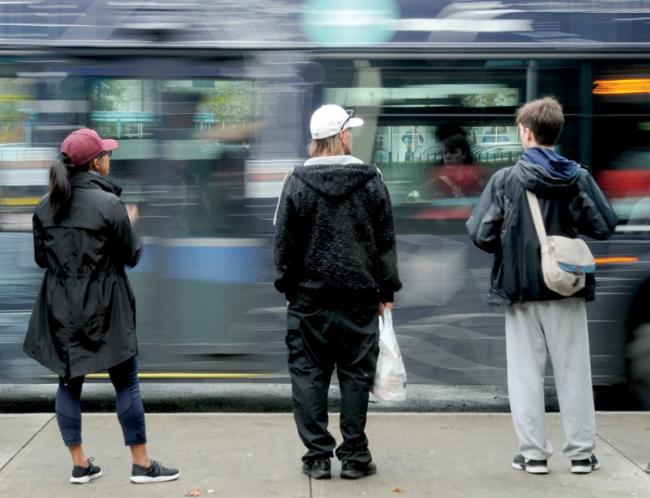Articles Menu

Last year something shocking happened in Seattle — people voted to paint “Bus Lane” along seven major arterials, onto what was space for parking and driving cars. And there was not much of a fuss.
A decade ago, this would have been seen as a wildly radical move and pundits across the continent would have set their hairpieces on fire. But now, gradually re-allocating road space from general purpose and parking use to exclusive 24/7 public transit lanes is becoming normal in many cities — even in the United States.
This is a good thing. But the Paris climate agreement makes it clear that we need to take bold leaps, not small steps, to avoid catastrophic global warming. And re-allocating a lot of space on urban roadways — quickly — could be one of the leaps that makes a real difference.
At this point, you may well be thinking that re-allocating a lot of road space to transit would make traffic congestion terrible. But long experience and numerous studies shows that traffic volumes expand and contract with the amount of road space, without travel speeds for cars and trucks changing much.
The cliché “you can’t build your way out of congestion” is well proven and understood. Most people understand that widening urban roads or freeways leads to wider traffic jams and more pollution.
What happens is called “induced congestion” — the extra road space encourages people to drive more until congestion is severe enough to start discouraging driving again. Induced congestion can be very quick; for example the Alex Fraser Bridge in Metro Vancouver was heavily congested within a year of opening.
The inverse of induced congestion is sometimes called “disappearing traffic.” In her 1961 classic The Death and Life of Great American Cities, Jane Jacobs wrote about how after the road through Washington Square Park in New York was closed “cars — just disappeared into thin air.” Traffic did not increase on the surrounding streets as many had predicted.
Over the last half century, many similar experiences of disappearing traffic have been documented. And since a bus lane can carry five to 10 times as many people as a lane of cars, well-designed bus lanes can handle decades of increasing transit ridership on most routes.
The most dramatic bus lane paint-in ever took place well before the climate crisis was making unprecedented floods and other disasters the new normal. After the 1973 oil shock, Zurich, Switzerland, created a still unprecedented network of exclusive transit lanes and signal priority for both streetcars and buses.
At that time, transit signal priority (traffic signals designed so that transit vehicles don’t have to stop at traffic lights) had to be invented from scratch. Now, multiple manufacturers provide transit priority systems. Every year the Zurich transit authority gets closer to its goal of never having transit passengers delayed by cars.
Zurich now has the highest transit ridership in Europe, largely created with cans of paint and cleverly applied electronics controlling traffic lights. And traffic congestion is less of a problem than in most European cities.
Globally, transportation is the fastest-growing source of carbon pollution and Environment Canada expects that Canada’s transportation pollution will be higher in 2020 than in 2012.
About a quarter of Canadian carbon pollution comes directly from the transportation sector — from the tailpipes of cars, trucks and airplanes, and that does not include the pollution from extracting and refining fuel or building new roads and bridges.
Road space in cities is mainly controlled by municipal governments, the most accessible level of government. And peer pressure between cities does not end at national boundaries. Seattle and Zurich’s examples can help Vancouver, Toronto or New Delhi residents pressure their local governments to do likewise.
The climate crisis is global, but some of the most important solutions are in the hands of your local city council. It is time to help them to crack open a whole lot of paint cans.
Eric Doherty is a Vancouver-based transportation planning consultant.